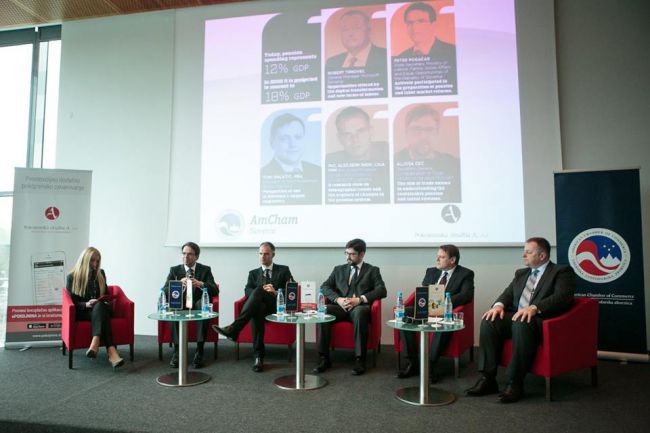Slovenia is facing many challenges in the field of pension system sustainability. It is necessary to recognize that a financially secure retirement is a concern for all stakeholders, the government, employers, employees, pensioners and those entering the labor market. At the same time, the pension system is opening up a range of business opportunities – but it is a marathon, not a sprint.
Peter Pogačar, State Secretary at the Ministry of Labour, Family, Social Affairs and Equal Opportunities of the Republic of Slovenia, outlined several challenges of the pension system and the labor market. He emphasized the key dilemmas of demographic projections: "Our demographic projection indicates a negative image. Only 57 percent of those aged 20 – 64 are employed, while the figure should be 75 percent. Employees therefore have the arduous task of supporting the rest of the population. In 2040, one worker will have to support one pensioner.”
Pogačar added that the importance of the pension system reform lies in its long-term implications: "The last reform of the pension system was effective, so now is not the time for another reform. It is essential to find a consensus between the generations, to include both the young and the old in the debate. The pension system functions in the long run and should not be reformed every time the government changes."
Among the challenges Slovenia is facing in the coming years are labor shortages, the problem of unskilled labor, an aging workforce and reducing the risk of poverty among the elderly. "Slovenia must attract young people, we need more people on the labor market. Our focus should be the second pillar. We must not forget, however, that the first pillar is to remain the main source of funding. Slovenia must wake up and send a clear message to its people regarding the necessary changes, but without scaring them," concluded Pogačar.
Dr. Aleš Berk Skok, CAJA, FRM, Associate Professor of Economics, University of Ljubljana, pointed out that pension schemes must be evaluated individually: "There is no one-size-fits-all system. Slovenia does not have a diversification of pension receipts; contributions are its main funding sources." He stressed the need for a combination of funding from the labor and capital markets. As an example of good practice of capital market profitability, he mentioned Australia. He concluded by stating that we should systemically start encouraging savings: "To achieve the desired pension scheme results in 10-20 years, we must start acting today.”
Aljoša Čeč, Secretary General of the Confederation of Trade Unions of Slovenia PERGAM commented on raising awareness of the labor force: “When discussing the issue of savings in the second and third pillars, we must ask ourselves if there are sufficient revenues for savings in those sectors in the first place. In promoting the second pillar, the state should channel more funding for the first pillar through taxes." He added that in the future, trade unions will concentrate on how to define and achieve a decent pension.
Toni Balažič, CEO of Mercator, presented the needs of older people as consumers. From the point of view of the silver economy he highlighted concerns about the purchasing power of Slovenian pensioners. He concluded: "The pension system reform is not the only important factor. Without a change in the tax system and an increase in productivity and purchasing power of the active population, the situation will not improve. "
Robert Trnovec, General Manager of Microsoft Slovenia, expressed his views on necessary solutions both at individual and systemic levels. He highlighted technological solutions being developed for older people at Microsoft. Trnovec further warned about the need to develop skills of all generations. “The problem is not only with the elderly. Everyone’s skills must be relevant for employment. Only the most technologically proficient will get jobs.”
Žiga Vižintin, Management Consultant Pokojninska družba A, presented a few facts on the second pension pillar in Slovenia: "In Slovenia, 58.9% of those under the compulsory Pension and Disability Insurance (PIZ) are included in the second pillar, which is not bad for a system that has existed since 2001. Worrying however, are the low monthly payments, which currently stand at 1.9% of the average gross wage and the annual decline in the numbers of those included in savings schemes.”
Andreja škofič Klanjšček, Director of the tax and legal department at Deloitte Slovenia, drew attention to the adequacy of tax relieves and incentives: "If a company, which it is paying the supplementary pension insurance for its workers, is operating at a loss within that year, it is not eligible for a tax relieve." She added that individuals can also enroll in the retirement savings schemes, in which case they are entitled to a full tax break individually or through their employers.
Vižintin emphasized: »We need to start saving on our first day of work. If employers notify their workers of the existence of the pension savings schemes, that is already positive, as many young people are not even aware of their existence. The employers have a key role to play, because they are the contact between savings and the employees."
Related to the above, mag. Eva Cvelbar Primožič, Executive Director of Human Resources at Kolektor Group, emphasized that the crucial moment is raising awareness about the pension savings in the first stage of recruiting new workers. “Among 2,260 employed at Kolektor in Slovenia, 94% are enrolled in the pension savings scheme, most of them through collective savings.”
You can find photo gallery HERE.

Sponsor:

